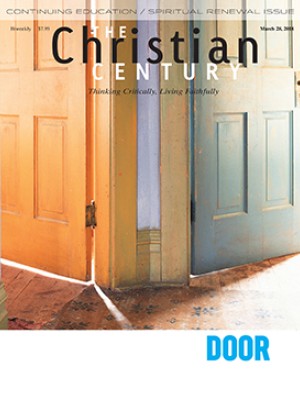
I vividly remember walking up the front steps to the door of the Kansas City church where I was to interview for my first pastorate. Nothing but a door stood between my 28-year-old eagerness and a group of people with whom I’d soon fall in love and spend the next eight years working for Jesus. The windowless door was a thick oak slab hung with gigantic hinges and original hardware. The cornerstone beside it read 1928. I grabbed the handle, thumb-pressed the latch, and pulled. The door didn’t budge. I decided I must be at the wrong entrance. But I yanked harder a second time and it opened, almost knocking me over.
I don’t recall any details of the interview, though that was the day I realized that every guest’s first encounter with a church building starts with the door handle. If the door and handle aren’t welcoming, it may be a sign that the practice of hospitality inside is out of whack as well. Those doors were a pain. They swelled after every rain. Our first capital campaign had four new entry doors at the top of the project list.
Read our latest issue or browse back issues.
Over the years, my sense of church doors as hospitality devices morphed into a metaphorical understanding of them as indicators of opportunity. The more doors a church has, I like to say, the higher the odds that its ministry is vibrant. I don’t mean physical doors of wood, metal, and glass. I have in mind multiple access points by which people enter into the life of a church in varied and meaningful ways.
The word for door in the New Testament, thura, has three meanings. It can mean simply a door but also “the opening of a cave or tomb.” Finally, the word means “an opportunity, a favorable time for accessing a possibility,” a bit like the French word entrée. It’s this third sense that has job seekers today looking for someone to “open a door” for them, or Paul writing to the Corinthians about a “great door” (megale thura) that opened for him to minister longer in Ephesus.
In Greek mythology, Kairos (Caerus) was the god of opportunity. Depicted as a youth with a single lock of hair dangling from his forehead, Kairos or opportunity could only be grasped as he approached. Once he passed by, no one chasing after him could grasp him, for the back of his head was bald. Inaction or neglect meant an opportunity missed.
I just finished a biography of Mickey Mantle, the baseball great whose life was marked by alcoholism and, at the end, an awareness of how many opportunities he had squandered. In his final press conference, days after receiving a liver transplant in 1995, Mantle spoke with regret. “Although I’ve heard people say they’d like to have my heart . . . it’s never been used,” he reflected. “God gave me everything, and I just . . . pffft!”
Mantle’s regret for all that passed him by brings me to the subject of Easter. Christians who understand the power of Easter learn that thura isn’t just an unwieldy tombstone or an opening to a cave. It’s also an opportunity—a kairos moment—to turn dark shame into bright hope. The resurrected Jesus isn’t bald on the back of his head, but scripture tells us he has “gone ahead to Galilee.” We’ve been chasing the opportunity to live more like him ever since.
A version of this article appears in the print edition under the title “Entry points.”






